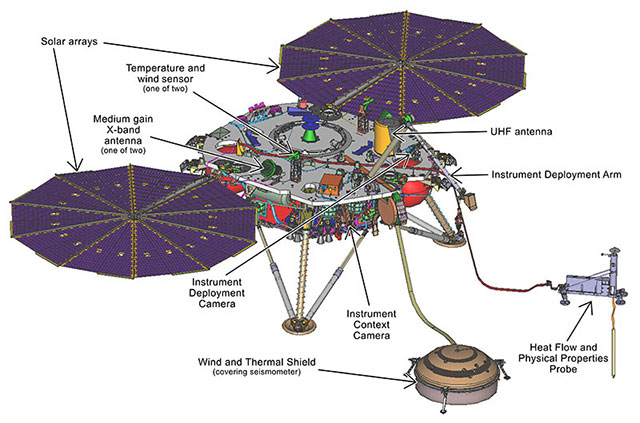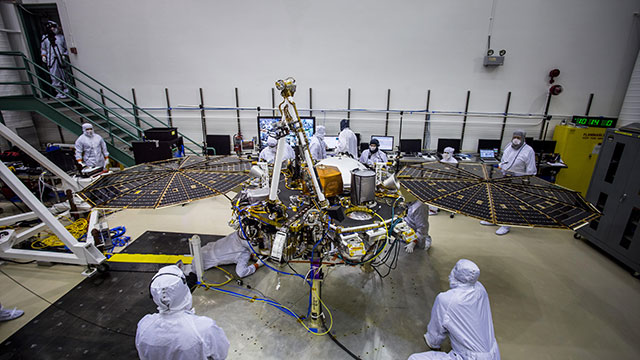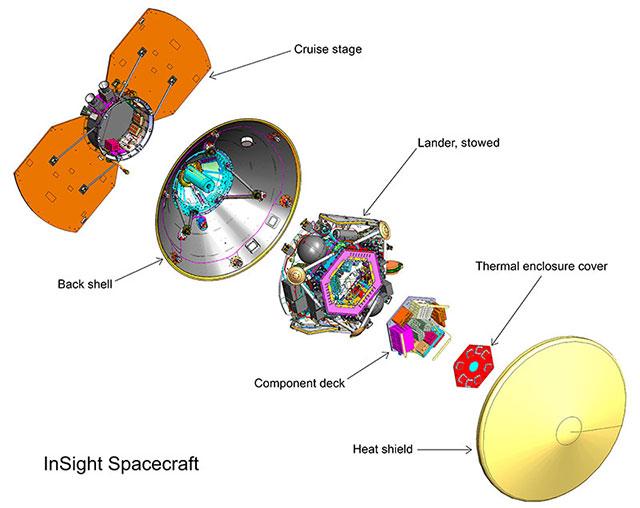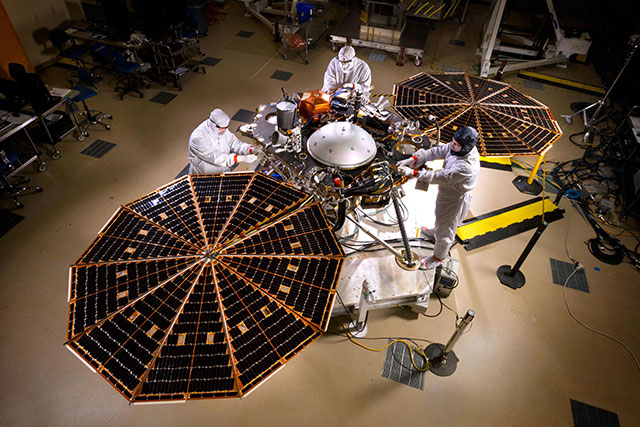The InSight lander will face south and the mission’s workspace will be the ground within reach of the robotic arm on the south side of the lander. Because the site is north of the equator, this will prevent the lander’s shadow from passing over deployed instruments. The lander’s two solar arrays will extend like circular wings east and west from the central deck, with a wingspan of 19 feet, 8 inches (6 meters). Front to back, the lander is 8 feet, 10 inches (2.7 meters) deep. The top of the deck will be 33 to 43 inches (83 to 108 centimeters) above Martian ground level, depending on how far the three shock-absorbing legs compact after the landing. With its solar panels deployed, the lander is about the size of a big 1960s convertible.

In this illustration of the InSight lander’s deployed configuration, south would be toward lower right at the Martian work site, with tethered instruments on the ground and the heat probe’s mole underground. Credit: NASA/JPL-Caltech/Lockheed Martin Space Download image
The lander’s panels are based on the design of those flown on NASA’s Mars Phoenix Lander, though InSight’s were made slightly larger for more power output and to increase structural strength. These changes were required to support the two-year landed prime science mission with sufficient margins (two Earth years, one Mars year).
Hardware on top of the deck includes the robotic arm, two dedicated science instruments and their accessories, a laser reflector, a helical UHF antenna and two X-band antennas (which are also used as part of a science experiment). In the weeks after landing, the arm will lift the seismometer, its Wind and Thermal Shield and the thermal probe from the deck and place them onto the Martian surface.
The lander’s avionics are mounted to a component deck located within a thermally protective enclosure. This suite of electronics consists of the flight computer, the electrical power system, the landed telecommunications system, the payload electronics and the harness. Other components, such as the inertial measurement units, radiometer, magnetometer and landing radar, are externally mounted under the science deck. Thrusters extend from the sides of the lander.

Engineers at Lockheed Martin Space, Denver, test the solar arrays on NASA’s InSight lander several months before launch. Credit: NASA/JPL-Caltech/Lockheed Martin Space
Instrument Deployment System: One Arm and Two Cameras
The lander’s Instrument Deployment System (IDS) has a robotic arm for moving instruments from the deck onto the ground and two color cameras for finding the best place to put them and documenting the process. One of the cameras is mounted on the arm; the other on the front of the lander, beneath the south edge of the deck.
The Instrument Deployment Arm (IDA) includes a grapple for grasping each piece of hardware that the arm will lift. The grapple’s five mechanical fingers can close around a handle that resembles a ball on top of a stem. Each of the three items that the arm will lift has one of these handles. The three items are the Seismic Experiment for Interior Structure (SEIS), the Heat Flow and Physical Properties Probe (HP³), and the seismometer’s Wind and Thermal Shield. The arm is 5.9 feet (1.8 meters) long, with shoulder, elbow and wrist joints and four motors. The grapple is at the end of the arm. The arm-mounted camera is between the elbow and wrist.
The camera on the arm is called the Instrument Deployment Camera (IDC). The lander’s other camera, the Instrument Context Camera (ICC), is mounted just below the deck, on the edge of the lander facing the workspace, which is the area of ground within reach of the arm. Both are modified versions of engineering cameras on NASA’s Mars rovers Opportunity and Curiosity, with full-color capability added. Each has a square charge-coupled device (CCD) detector that is 1,024 pixels by 1,024 pixels.
The IDC’s field of view is 45 degrees wide and tall. Movement of the arm is used to point the camera. The IDC will image the workspace in detail to support selection of the best specific locations for the deployed instruments. It will also image hardware to verify key steps are accomplished in the deployment process before proceeding to the next step. By moving the camera’s position between exposures, the IDC can create stereo views that provide three-dimensional information about the surrounding area. The camera can be pointed in any direction, so it can take images to be combined into a 360-degree panorama of the lander’s surroundings. The ICC has a “fisheye” field of view of 120 degrees. It will provide wide-angle views of the entire workspace. The basic structure of the robotic arm was originally built for a Mars lander planned for launch in 2001, but that mission was cancelled before launch. JPL refurbished and modified the arm for InSight, including the additions of a grapple and camera. JPL also developed the software for controlling the arm and built both of the Instrument Deployment System’s cameras.

NASA’s InSight mission tests an engineering version of the spacecraft’s robotic arm in a Mars-like environment at NASA’s Jet Propulsion Laboratory. The Instrument Deployment Camera is visible at the “elbow” of the arm.
Science Experiments
InSight will be using its science experiments to take the “vital signs” of Mars: its pulse (seismology), temperature (heat flow) and its reflexes (radio science). The Seismic Experiment for Interior Structure (SEIS), a seismometer that measures ground motions in a range of frequencies, features six sensors of two different types. Those sensors are mounted on a three-legged precision leveling structure inside a remote warm enclosure box. That combination will be set directly onto the ground, connected to the lander by a flexible tether containing power and data lines. Then an additional protective cover -- the Wind and Thermal Shield -- will be placed over it. The SEIS electronics box remains on the lander.
France’s national space agency, Centre National d’Études Spatiales (CNES), Paris, leads the consortium that provided SEIS. InSight’s second dedicated science instrument, Heat Flow and Physical Properties Probe (HP³, pronounced “H-P cubed”), will provide the first precise determination of the amount of heat escaping from the planet’s interior. InSight’s robotic arm will place the instrument on the ground, where a self-hammering mechanical mole will burrow to a depth of 10 to 16 feet (3 to 5 meters) over the course of about 30 days. InSight’s heat probe will penetrate more than 15-fold deeper beneath the surface than any previous hardware on Mars.
A science tether with temperature sensors connects the upper end of the mole to the HP³ support structure, which is on the Martian surface. An engineering tether connects HP³ support structure to the instrument’s back-end electronics box on the lander.
The HP³ investigation also includes a radiometer to measure ground-surface temperature near the lander based on its infrared brightness. The German Aerospace Center (Deutsches Zentrum für Luft- und Raumfahrt, or DLR), headquartered in Cologne, provided InSight’s Heat Flow and Physical Properties Probe.
A third science experiment, the Rotation and Interior Structure Experiment (RISE), does not have its own dedicated science instrument; instead, it uses InSight’s direct radio connection with Earth to assess perturbations of Mars’ rotation axis, which can provide information about the planet’s core. The tools for RISE are the X-band radio on the InSight lander and the large dish antennas of NASA’s Deep Space Network. The lander’s radio link to Earth will provide precise tracking of the location of one site on the surface as the planet rotates, throughout the course of a full Mars year.






